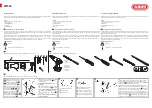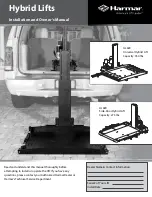
Duct and Duct Connections
(refer to design drawing)
•
4 x 125mm nominal diameter spigots are provided for the connection of ducting. These are clearly marked
for correct connection of the supply and exhaust ducts. Flexible duct fits over the spigots, whilst rigid duct fits
into the spigots.
•
Where ducting is installed in an unheated space, all of the ducts should be insulated. Where ducting is in
stalled in a heated space, only the cold ducts should be insulated. i.e. the supply duct from outside and the ex
tract duct from the unit to the outside.
•
The duct layout must be designed to suit the requirements of the ventilation/recovery system and building lay
out. If the ducting passes through a fire wall/barrier, suitable fire dampers must be installed.
•
Where rigid duct is used, it should be installed using the least number of fittings to minimise air flow resist
ance. Where possible, final connection to the grilles and unit should be made with a flexible connection.
•
Where flexible ducts are used, ensure that:
-
duct runs are kept as short as possible
-
the duct is stretched so that it is smooth and straight
-
where bends are necessary, they have large radii (ie avoid sharp bends)
-
the duct is not crushed if in a restricted area
•
The inlet for the fresh air supply can be directly from outside, or from within a ventilated roof space. If the sup
ply is directly from outside, it must have an external wall grille fitted if supplied through a wall, or a recognised
roof terminal if supplied through a roof. If the supply is from a ventilated roof space, it must be protected by
a filter box.
Condensation
(the unit may sometimes produce condensation which must be drained away. A 15mm dia pipe connection is
provided on this unit).
•
A 15mm dia pipe must be fitted to the pipe connection. If any part of the condensate drain is in an
unheated space it MUST be insulated with the equivalent of at least 25mm of insulating material with a
thermal conductivity of 0.04 W/(mK).
•
The drain must incorporate a U-bend to prevent air penetration.
•
The pipe must drain into the normal household drainage system.
•
The unit must be tilted towards the side carryng the condensation exit point. It should be installed
horizontally with a 3º tilt towards the condensation drain used (equivalent of raising the opposite end by
approximately 25mm).
•
. Four possible condensation drain points are provided, which allow the installer to turn the unit through 180
O
to simplify duct layout and connections.
Electrical Connection
WARNING: these appliances must be earthed and all wiring must conform to current IEE Regulations and
all applicable standards and Building Regulations.
• The unit is suitable for 230V, 50Hz Single phase supply fused at 3A.
• The unit is supplied with a mains rated 4 core flexible cord (black, brown, grey and green/yellow)
• A triple pole isolation switch with contact separation of at least 3mm must be used to connect the appli-
ance to the fixed wiring when using the Switched Live.
• Boost controls must not be located within 1 metre of a cooker or where they may be affected by
excessive heat or moisture
• Boost controls should be clearly identified and conveniently located.
• The boost switch wiring cable access is via a 12mm cable gland.
• The boost speed can be triggered by a switched live connection from a variety of external devices including:
- PIRFF (passive infra red)
*
-
DRH240 (dynamic remote humidistat)
*
-
THM (thermostat)
*
-
a light switch (if more than one light switch is used,
each one must be a double pole switch)
- a remote switch/pull cord
(
*
PIRFF, DRH240 and THM may have integral over-run timer which controls the length of time that the fan
will continue to operate at its boost speed after the boost has been switched off.)
























